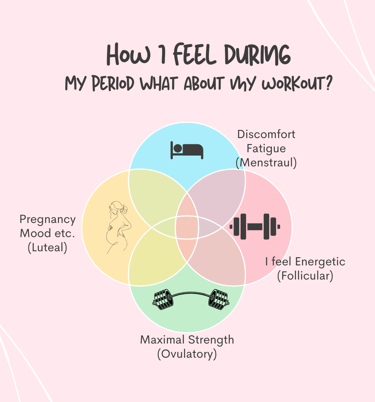Understanding Your Menstrual Cycle and Its Impact on Fitness
"What I Learned as a Coach"
Coach Gabe
6/13/20258 min read


Introduction to the Menstrual Cycle
The menstrual cycle is a fundamental aspect of women's health, playing a crucial role in various biological and physiological processes. Typically lasting approximately 28 days, although variations are common, the cycle is divided into four distinct phases: menstrual, follicular, ovulatory, and luteal. Each phase is characterized by unique hormonal changes that can significantly impact a woman’s physical performance, energy levels, and overall well-being.
The menstrual phase marks the beginning of the cycle, where the uterine lining sheds if pregnancy has not occurred. This phase can often result in discomfort and fatigue, affecting an individual’s ability to engage in high-intensity workouts. Women may find themselves needing to adapt their fitness routines to accommodate symptoms such as cramping and mood fluctuations during this time.
The Four Phases of the Menstrual Cycle
The menstrual cycle consists of four distinct phases: the menstrual phase, the follicular phase, the ovulatory phase, and the luteal phase. Each of these phases is characterized by varying levels of key hormones, particularly estrogen and progesterone, which play significant roles in influencing physical performance and emotional health.
The menstrual phase marks the beginning of the cycle, typically lasting 3 to 7 days. During this phase, both estrogen and progesterone levels drop, leading to the shedding of the uterine lining. Women often experience fatigue and discomfort, which can impact energy levels and motivation. However, light exercise can help alleviate some symptoms and enhance overall well-being during this period.
Following menstruation, the follicular phase begins. This phase lasts approximately 7 to 14 days and is characterized by rising estrogen levels as the body prepares for ovulation. Increased estrogen promotes muscle growth and recovery, making this an optimal time for strength training and high-intensity workouts. Individuals may notice enhanced energy levels and improved mood during this phase, making it an ideal time for setting and achieving fitness goals.
Ovulation occurs on approximately day 14 of the menstrual cycle and is marked by a peak in estrogen levels. The ovulatory phase typically lasts around 1 to 2 days. During this time, women may experience increased energy and vitality, leading to optimal performance in both strength and endurance exercises. It is during this phase that the potential for peak physical performance is likely to be realized.
Finally, the luteal phase follows ovulation and lasts approximately 14 days. During this phase, progesterone levels rise, preparing the body for a possible pregnancy. As progesterone levels increase, some women may experience symptoms such as bloating, mood swings, and decreased energy. While the body may feel less inclined to engage in high-intensity workouts, moderate exercise can still provide benefits. Understanding the hormonal fluctuations throughout these four phases can empower women to tailor their fitness routines accordingly, promoting both physical and emotional health.
Hormonal Shifts and Their Impact on Fitness
The menstrual cycle is characterized by a complex interplay of hormonal shifts, which plays a pivotal role in influencing various aspects of fitness. Key hormones such as estrogen, progesterone, and cortisol vary throughout the cycle, impacting strength, endurance, fatigue, and recovery. Understanding these fluctuations can help individuals tailor their fitness regimes to better align with their physiological state.
During the follicular phase, which commences on the first day of menstruation and continues until ovulation, estrogen levels begin to rise. This increase signifies a favorable period for strength training and endurance activities. Higher estrogen levels are associated with enhanced muscle strength and improved cardiovascular performance. Consequently, individuals may find they can sustain higher intensity workouts and recover relatively quickly during this phase.
As ovulation approaches, estrogen peaks, resulting in further physical benefits. However, post-ovulation marks the initiation of the luteal phase, during which progesterone levels rise and estrogen levels subsequently decline. The increase in progesterone can lead to feelings of fatigue and could cause a decrease in appetite. As a result, this phase may be less optimal for high-intensity training, as the body may require more rest and recovery. The rise in cortisol levels during this phase can also contribute to heightened stress responses, further impacting performance and recovery times.
Recognizing the influence of hormonal shifts is crucial for those engaged in fitness routines. By understanding the dynamic nature of these hormones, individuals can modify their training schedules, prioritize certain types of workouts, and incorporate adequate recovery strategies to align with their menstrual cycle. This strategic adaptation allows for improved performance and a more holistic approach to fitness throughout the cycle.
Listening to Your Body: Energy Levels in Each Phase
Understanding the menstrual cycle is essential for optimizing fitness and overall well-being. The menstrual cycle consists of several phases—menstrual, follicular, ovulatory, and luteal—each bringing distinct hormonal changes that can significantly influence energy levels and physical performance. By familiarizing yourself with the natural shifts in these energy levels, you can enhance your workout efficiency and recovery.
The menstrual phase typically involves lower energy levels, as the body sheds the uterine lining. During this time, you may experience fatigue or discomfort. It's beneficial to listen to your body and adjust your exercise intensity accordingly; choose gentler activities such as yoga or light cardio to maintain movement without overwhelming your system.
As you transition into the follicular phase, estrogen levels begin to rise, and energy often increases. This is an ideal time to engage in higher-intensity workouts, including strength training or aerobic exercises. Your body is primed for performance, and tapping into this energy can lead to improved results. Be mindful of your body’s cues; while you may feel more energetic, it is still crucial to maintain proper hydration and nutrition.
The ovulatory phase is characterized by peak estrogen levels, which can further boost your energy. During this time, many women experience heightened strength and endurance. It is an excellent opportunity for high-intensity interval training (HIIT) or competitive sports. However, the increase in energy may also lead to overexertion; therefore, remain attuned to your body's limits.
In the luteal phase, the rise in progesterone may result in a gradual decline in energy levels, often accompanied by mood fluctuations or physical discomfort. While it may be tempting to push through, adapting your training by incorporating lower-intensity exercises, such as walking or swimming, can enhance recovery and well-being. Awareness of these natural cycles allows for smarter training decisions, ultimately supporting fitness goals and overall health.
The Risks of Consistent Workout Intensity
Maintaining a consistent level of workout intensity throughout the menstrual cycle can pose significant risks to overall health and fitness. The menstrual cycle is characterized by hormonal fluctuations that influence energy levels, strength, and endurance. Therefore, ignoring these natural changes and adhering to a uniform intensity in training can lead to various negative consequences.
One of the primary concerns associated with a static workout regimen during the menstrual cycle is the increased likelihood of fatigue. Different phases of the cycle, particularly the luteal phase, often bring about changes in energy levels due to hormonal shifts, notably a rise in progesterone. When individuals push their bodies to perform at the same high intensity throughout these phases, they may experience substantial physical and mental fatigue, which can hinder motivation and lead to diminished performance.
Moreover, adhering to a high-intensity workout could increase the risk of injury. During particular times in the menstrual cycle, joint stability may be compromised due to hormonal influences, which can make the body more susceptible to strains and other musculoskeletal injuries. Increased joint laxity, combined with consistent high-impact workouts, can heighten this risk considerably. Listening to the body and adjusting workout intensity to align with the cycle can serve as a preventive measure against injuries.
It is essential to recognize that the body’s capabilities fluctuate with the menstrual cycle. Emphasizing a more adaptable approach to fitness, which includes varying workout intensity according to these natural ebbs and flows, can enhance overall performance while safeguarding health. This nuanced perspective ensures that individuals do not exhaust themselves or compromise their well-being by attempting to maintain a constant workout intensity, thus promoting a healthier fitness journey.
Tailoring Your Fitness Routine to Your Menstrual Cycle
Understanding the menstrual cycle is crucial for developing a fitness routine that enhances performance and overall well-being. The cycle typically unfolds in four distinct phases: menstrual, follicular, ovulatory, and luteal. Each phase brings about hormonal changes that can affect energy levels, strength, and mood, and recognizing these fluctuations can facilitate the tailoring of workouts.
During the menstrual phase, which lasts about three to seven days, it is advisable to adopt a gentler approach to exercise. Low-intensity workouts, such as yoga or walking, can be beneficial during this time, as they help alleviate discomfort and promote relaxation. Listening to your body is essential; if it signals fatigue, consider using this phase for active recovery rather than intense training.
As the cycle transitions into the follicular phase, energy levels typically rise due to increasing estrogen. This is an opportune time to incorporate higher-intensity workouts and strength training into your routine. Engaging in activities such as anaerobic exercises or circuit training can be rewarding, as the body's ability to build muscle and endurance improves during this phase.
Moving into the ovulatory phase, which is marked by peak energy levels, it is suitable to maximize performance. High-intensity interval training (HIIT) and competitive sports often yield favorable results here, as physical capabilities are at their highest. However, one should remain attentive to individual responses and adjust intensity accordingly.
The luteal phase may bring about fluctuations in mood and energy as the body prepares for menstruation. Decreasing workout intensity and incorporating more moderate activities, such as Pilates or jogging, can be helpful. Ensuring sufficient rest and recovery is vital during this phase to prevent burnout and maintain overall motivation.
By aligning fitness routines with the menstrual cycle, individuals can optimize their physical activity, enhance performance, and foster a healthier relationship with their bodies throughout the month.
Conclusion: Empowering Your Fitness Journey
Understanding the menstrual cycle and its impact on fitness is essential for women looking to enhance their exercise routines and overall well-being. The cyclical nature of hormonal fluctuations can influence energy levels, motivation, and physical performance. By acknowledging these changes, individuals can tailor their workouts to align with their body’s natural rhythms, ultimately improving both their fitness journey and health outcomes.
Embracing one’s unique menstrual cycle is a powerful step toward empowerment in fitness. Each phase presents opportunities for various training intensities and recovery periods. For instance, during the follicular phase, women may find themselves more energetic and able to engage in high-intensity workouts. Conversely, the luteal phase may warrant modifications in training intensity and focus on recovery. By syncing their workout schedules with their cycles, women can maximize their potential and personalize their fitness approach.
It is important to remember that every woman’s experience is different; therefore, there is no one-size-fits-all solution. Encouraging an adaptive mindset can promote long-term success in health and fitness. This involves not only recognizing the impact of the menstrual cycle on physical activity but also advocating for self-compassion during less optimal days. Women are encouraged to listen to their bodies, track their cycles, and seek strategies that resonate with them individually.
Ultimately, the journey to fitness is an ongoing exploration. By understanding the interplay between the menstrual cycle and fitness, women can make informed decisions that honor their bodies. Embracing this knowledge not only paves the way for improved physical health but also fosters a deeper connection to one’s self, reinforcing the importance of alignment between fitness practices and natural biological rhythms.
Coach Observation !
In training female clients I noticed the reduction in abilities and output of power but in full transparency it is impossible for me to pretend to understand the chemical and physiological changes.
Also noticed joint and mobility issues. NEVER TO LATE TO LEARN I DID!!!!
Ladies though I tailor your workouts this is a team effort please try to schedule your maximal lifts with chart below.


